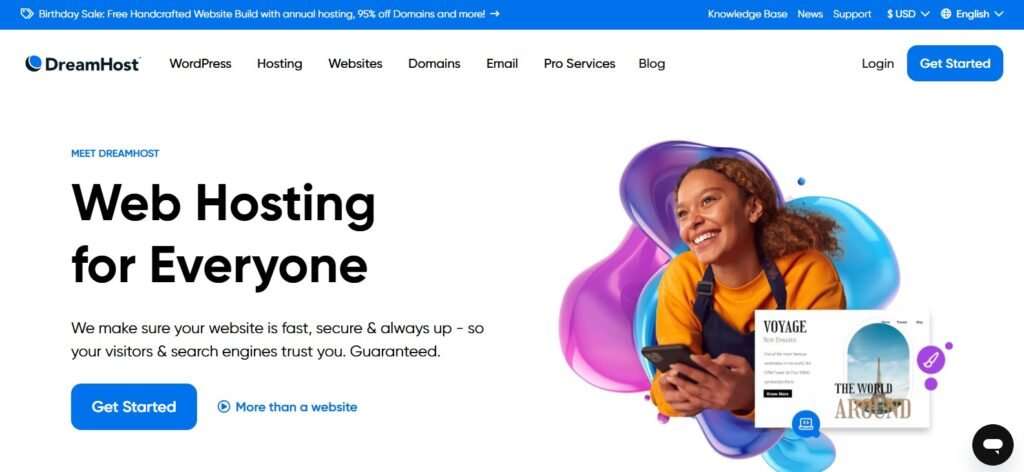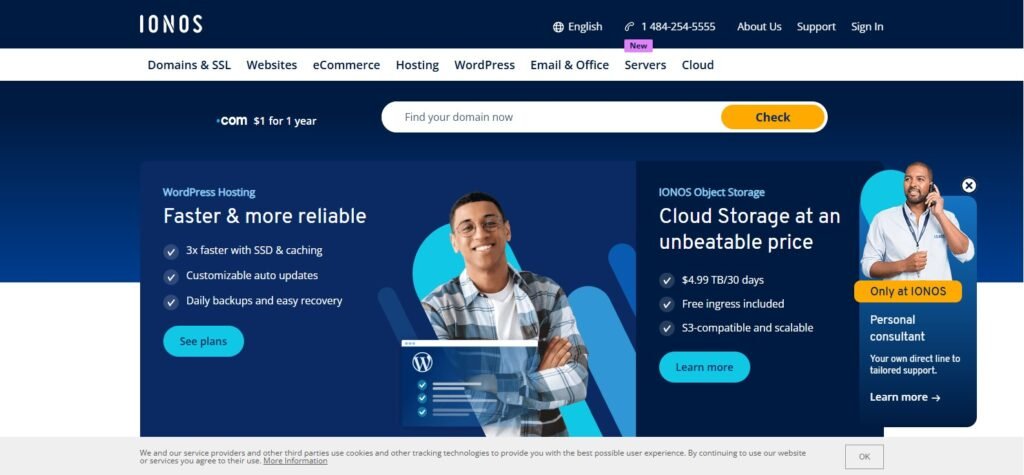If you’re just starting out with WordPress — maybe your first blog, portfolio, or small business site — the last thing you want is to get bogged down with server configurations, command-lines, and hosting jargon. You want something cheap, yet reliable, and “managed” enough that the hosting company handles most of the complexity for you.
That’s where cheap managed WordPress hosting comes in. It’s a sweet spot: low cost + hosting provider manages WordPress core updates, security, backups, and performance optimizations. In 2025, there are multiple providers tailored for beginners and non-technical users offering great value. This article will walk you through what managed WordPress hosting means, what features a beginner should look for, how to evaluate cheap plans, and which providers stand out in this space.
What “Managed WordPress Hosting” Means for Beginners
Let’s clarify this upfront: “managed” doesn’t mean you do nothing — you still create content, choose themes, and install plugins. But it means the hosting provider will handle the server side, so you don’t have to:
- WordPress core updates and security patches handled automatically.
- Server stack optimized for WordPress (e.g., caching, PHP version, SSD storage).
- Backups (daily or frequent) included.
- Free SSL certificate and often one-click WordPress installation.
- Support team comfortable with WordPress and beginner-friendly.
For non-technical users, this shifts your focus from “how do I get the site running” to “what content do I put on the site” — which is exactly what you want.
But because you’re looking for cheap, you’ll trade off some advanced features (e.g., no super custom server configuration) in favor of simplicity and value.
What Beginners Should Prioritise (and What They Can Ignore)
When you are new and budget-conscious, you don’t need every high-end feature. Here’s a refined list of what you should care about now, and what you can add later.
Must-have features
- One-click WordPress installation – So you don’t wrestle with manual setup.
- Free SSL certificate – Essential for security and SEO.
- Automatic backups – Saves you from accidental loss.
- Managed updates – WordPress core and basic plugin/theme updates handled.
- Beginner-friendly dashboard – Clean UI, not overloaded with developer features.
- Good support – 24/7 chat or ticket support that speaks plain English.
- Acceptable performance – SSD/NVMe storage, decent loading time.
Nice-to-have (can add later)
- Staging site (for testing updates before going live)
- Built-in CDN (Content Delivery Network)
- Advanced caching and developer access (SSH, Git)
- Multiple website support (if you plan many sites)
- High traffic handling (if your site grows a lot)
Things you can ignore initially
- Complex server control panel features (unless you want to learn).
- Enterprise-level uptime guarantees (99.99% vs 99.9%).
- Very large bandwidth / resource allocations (if site is small).
By focusing on the must-haves, you’ll pick a plan that’s simple and cheap, but still professional enough to set you up for success.
How to Evaluate Cheap Managed WordPress Hosting
When you compare cheap managed WordPress plans, use these evaluation criteria to ensure you’re not getting stuck with hidden problems.
1. Intro vs Renewal Price
Cheap managed plans often have very low introductory pricing for the first term, and then steep renewal hikes. For beginners, this means you should check both first-term price and renewal price.
Example: Some hosts advertise $1/month for the first year, then $12/month after renewal.
2. Resource Limits
Even cheap plans should list storage, allowed websites, bandwidth or visits. If they don’t list them, assume they’re minimal.
Example: IONOS’s cheapest plan starts at $1/month for 50 GB SSD storage and one website.
3. Hosting Features for WordPress
Check that the plan includes a managed WordPress environment (automatic updates, optimized stack). For example, “WordPress optimized servers” or “managed WordPress hosting” keywords.
4. Beginner Friendliness
Check for simple dashboard, one-click install, free domain (often first year), support responsiveness.
Example: TechRadar recommends hosts for beginners that offer site-builders and full assistance.
5. Real-world Performance & Support
Cheap doesn’t have to mean slow. Look for reviews showing uptime and response times for the provider. ThemeIsle review notes IONOS had ~2 seconds load time across regions.
6. Hidden Costs and Fine Print
Look out for: limited websites allowed, higher renewal costs, excluded backups, extra fees for migrations, domain renewal cost.
Example: IONOS’s low $1/month intro is only valid for a specific term.
Budget-Friendly Managed WordPress Hosting Providers for Beginners
Here are five providers that strike a good balance between cost, simplicity, and managed WordPress features — especially suited for non-technical beginners.
1. Hostinger

Hostinger offers one of the best value-for-money managed WordPress hosting plans for beginners. Their custom hPanel is intuitive, one-click WordPress install is included, and they support features like LiteSpeed caching.
According to WPBeginner: “Known for their affordable plans and beginner-friendly interface, Hostinger provides exceptional value without compromising performance.”
Why it’s good for beginners: Very low entry price ($2-4/month for initial term), beginner friendly dashboard, decent support, free SSL + domain in many cases.
Things to note: Renewal prices will increase; the lowest plans may have limited resources if your site grows.
2. Bluehost

Bluehost is officially recommended by WordPress.org and provides managed WordPress plans that begin very affordably. They emphasise “one-click WordPress installation” and “no coding required” for beginners.
Why it’s good for beginners: Trusted brand, easy setup, free domain first year, solid support.
Things to note: Renewal costs go up; basic plan supports limited number of sites and resources.
3. DreamHost

DreamHost offers a range of WordPress hosting plans aimed at beginners. Their “WordPress Hosting Launch” plan starts around $2.99/month for the first year and includes daily automated backups, free domain, unlimited bandwidth.
Why it’s good for beginners: Transparent pricing, dedicated WordPress-focused features, good reputation for support.
Things to note: Simpler than enterprise managed plans; ensure you select the WordPress-optimized package for best ease of use.
4. IONOS

IONOS is among the lowest cost options. Their WordPress hosting starts at just $1/month for some introductory offers — making it hard to beat for pure budget beginners.
Why it’s good for beginners: Extremely low entry cost; includes free domain and SSL; simple setup wizard.
Things to note: That low cost is introductory only; renewals increase; only one site allowed in some plans; check feature set carefully.
5. Namecheap EasyWP

Namecheap’s EasyWP platform offers very affordable managed WordPress hosting. TechRadar notes it “is likeable for novices and the budget-conscious.”
Why it’s good for beginners: Low price, simple interface, free CDN (in some plans), supports WordPress without complexity.
Things to note: Many features missing in the cheapest plan (staging, multiple sites); may require upgrade for growth.
Which Plan Should You Choose as a Beginner?
Here’s a quick decision guide:
- If you’re creating a single blog or personal site: Go for a plan that supports 1 site, with free domain + SSL, minimal cost. Example: IONOS or Namecheap.
- If you plan to grow (e.g., several small pages, clients, or local business site): Pick a plan that allows multiple sites, has good support and basic performance headroom (e.g., Hostinger Premium or Bluehost Plus).
- Avoid ultra-cheap shared hosting that is not “managed WordPress”. If the plan is generic and you’ll still need to manage updates/backups yourself, you’ll lose the simplicity you were promised.
Important: Make sure you check renewal cost and resource limits (storage, sites, visits). Budget beginners often get surprised when price jumps after year one.
Setup Tips for Beginners After You Buy Managed WordPress Hosting
Once you sign up for a beginner-friendly managed WordPress hosting plan, follow this checklist:
- Use the one-click installer to install WordPress.
- Choose a simple, lightweight theme (fewer plugin dependencies).
- Install essential plugins only (SEO plugin, backup plugin if not included, caching plugin if permitted).
- Enable free SSL certificate (most managed hosts include Let’s Encrypt).
- Ensure automatic backups are enabled and test one restore.
- Use the hosting control panel’s beginner tools: site builder, staging, migration if available.
- Configure basic security settings: strong login password, enable 2FA if offered.
- Plan for growth: when traffic or functionality increases, be ready to upgrade plan rather than re-migrate later.
Beware of Hidden Costs and When You’ll Need to Upgrade
Even cheap managed WordPress hosting will eventually require an upgrade if your site grows in traffic, features, or complexity.
- When visits exceed plan limits or performance drops.
- When you add heavy plugins (eCommerce, LMS, membership).
- When you require more agents/users or multiple sites.
You’ll want to monitor site speed and resource usage—many hosts provide dashboards showing CPU or memory usage.
Also watch for hidden costs:
- Domain renewal fees.
- Add-ons like extra email accounts or backups.
- Required migration costs when upgrading to higher tier.
- Limitations on site number (one site only on cheapest plan).
FAQs
Q1. Can I really get managed WordPress hosting for under $5/month?
Yes — several good providers offer entry plans in the $2-5/month range for the first year (e.g., IONOS, Hostinger) as reviews show.
Q2. What happens after the first year?
Often the renewal price is higher — maybe $8-12/month or more. Always check the post-intro price.
Q3. Do I still need to manage backups and updates?
In managed WordPress hosting, most of this is handled by the host (automatic updates and daily backups), but you should verify the backup restore process and that automatic updates are on.
Q4. Is cheap managed hosting safe for my site?
Yes — if you pick a reputable provider with good reviews, and your site is small to moderate in traffic. For high traffic or critical business sites, you might want higher tier.
Q5. Can I switch later if I pick a cheap plan now?
Absolutely — many providers allow migrations to higher plans, or you can migrate to another provider later. Starting small is fine; just know upgrade path exists.
Conclusion
For beginners and non-technical users, cheap managed WordPress hosting is a smart way to get online quickly, without the burden of server management. You can focus on creating content, building your brand or business—and leave the technical side to the hosting provider.
Start with a plan that meets your immediate needs (one site, free SSL, backups, easy install), pick a trusted provider (Hostinger, Bluehost, DreamHost, IONOS, Namecheap), and monitor growth. As your site grows, you’ll be ready to upgrade—but you’ll start in the right place: simple, affordable, and managed.
Pick wisely, set expectations for renewal and growth, and your WordPress journey will be smooth, inexpensive, and stress-free.



